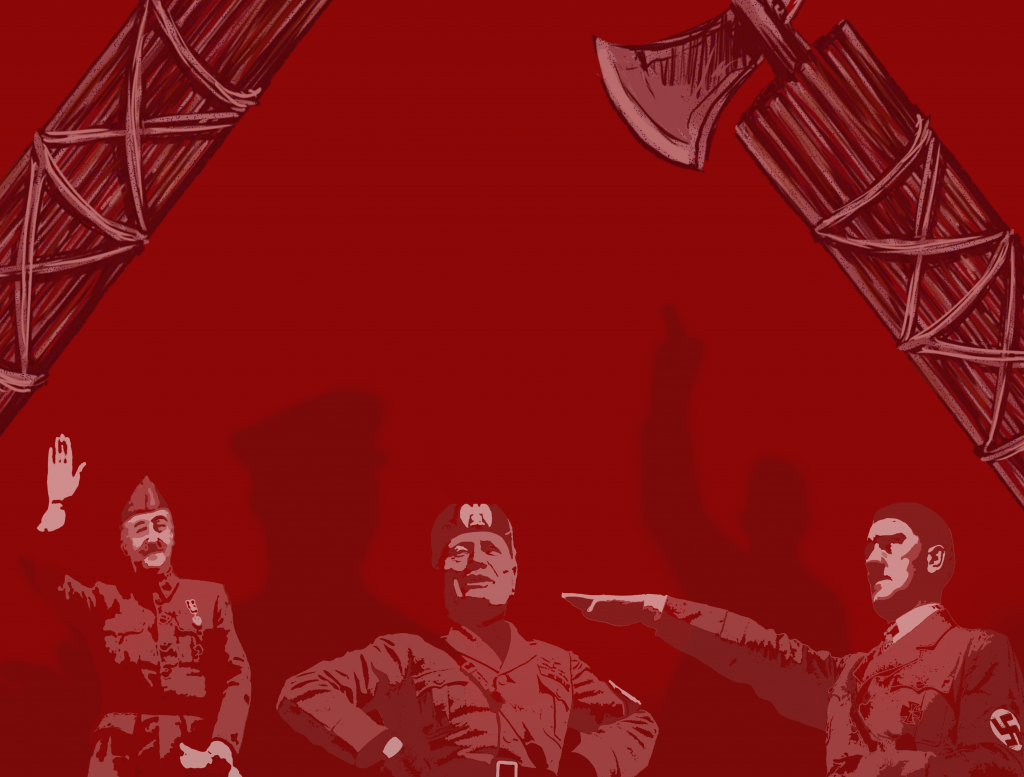Fascism is a regime that represses freedom, promotes discrimination and obstructs solidarity. It is undesirable for peace and coexistence. It is therefore important to distinguish what is and what is not fascism.
If we got used to saying that dogs are wolves, we would be caught unawares when the wolves came. The same can happen if we call what is not fascism fascism. Because fascism can exist again.
The word “fascism” comes from “bundle” (‘fascis’ in Latin). For example, many branches of firewood linked together make a bundle. We also speak of a “bundle” of banknotes or other types of bundles. Fascism is originally based on the image of a bundle and thinks, declares and acts like a bundle.
Fascism began in Italy only a century ago. It did not exist before. It can therefore be said to be a contemporary political movement. From the very beginning, those “fascists” used as the main emblem of their party the image of the bundle, fascio in Italian, which gave its name to the party itself: the Fascio.
Why the bundle? For two reasons. Because it represents the idea of an inseparable unity. In this case, that of the people. And because the image of the bundle, as the Fascists represented it, corresponded exactly to that of an object used by the authorities of ancient Rome as a symbol of their power and the standard of their legions.
This was the fascis, in Latin, which consisted of a bundle of 30 equal sticks of Omar or birch wood and an axe of the same size, all tightly bound together with a red leather cord and thus forming a perfect cylinder. The 30 sticks represented the 30 tribes of Rome and their indissoluble unity, which gave the empire its strength. It was the symbol that union is strength; but especially the sign that recalled the strength of the authorities of the empire and, in times of the republic, that of the dictator. The addition of the axe indicated, in any case, the power to impart justice and to punish.
From Rome in the 1930s
Power in ancient Rome was rich in symbols such as these, expressive of dominion, justice and glory, some of which, such as the eagle, the column, the thunderbolt and the laurel, are still found in many national coats of arms. The beam is, for example, on the United States Congress and the Spanish Guardia Civil. But the symbol of the beam must have been the one most akin to the Fascists’ ambition for imperial power.
The swastika, of Eastern origin, was the symbol of the German fascists, the “Nazis”, an apocope or abbreviation of the word “National Socialist”. This cross evoked for them the unity and power of what they called the “Aryan race”, as superior to the rest and antagonistic to the supposed “Semitic race”. The bright red colour surrounding the swastika is a reminder of the power and majesty with which this colour has always been associated. Like the fascists, the Nazis wanted to be restorers of empire: some of the Roman Empire, others of the Germanic Empire. While both political regimes ruled in Europe in the 1930s, the fascist-inspired Spanish Falange party was founded in Spain, which took as its emblem the yoke and five arrows, taken from the coat of arms of the monarchy of the Catholic Monarchs. The phalanx, by the way, was the name of a fighting unit of the ancient Greeks. The symbol of the Spanish “Falangists” also indicated power and the establishment of power in the union of the people. The arrows are linked and form an unbreakable unit with the yoke – a piece of wood that united the two bulls – because the arrows can be broken separately. The Falange, originally a minority, formed part of and had a decisive influence on the National Movement that gave way to and sustained the military dictatorship (1939-1975) of General Franco.
There have been and are military dictatorships (Castro, Pinochet, Videla), civilian dictatorships (Salazar, Perón, Nasser) or even theocratic dictatorships (Haile Selassie, Dalai Lama, Khomeini) with features similar to those of the fascisms just mentioned. There are, at the same time, forms of government and episodes, both in autocratic and democratic regimes, which are similar or comparable in some respect to fascism, in the characteristics of the latter, which we will summarise below. For example, the current regimes in North Korea, Venezuela and the Philippines, and in general whenever a government or a party behaves authoritarian and demands the inexorable unity and obedience of all. But we should not confuse these regimes and situations with fascism. Fascism existed and can exist again; in fact, there are social groups and political parties in Europe today which, whether they say so or not, are fascist.
The Nazis did not call themselves that, and they too were for a few years a ridiculous parliamentary minority, but then they took over half of Europe. Henry Ford, the American manufacturer, admired them, and so did Edward VIII, the King of England. There is no guarantee that similar sympathies would be forthcoming in the face of a possible return of fascism.
The claim to ‘totality
What distinguishes fascism from democracy is relatively easy: it is an autocracy. But what distinguishes it from dictatorships and other autocracies is not so easy. The best way to do this is to point out its most unique characteristic features. First and foremost, fascism is totalitarianism. In this sense, the Stalinist and Maoist regimes after World War II were also fascist. Mussolini’s slogan was: “Everything in the state. Nothing against the state. Nothing outside the state. Hitler’s was: “One People. One Empire. One Leader. Franco’s: “Spain One, Great and Free”.
In all three slogans there is a claim to “totality”. This is the essence of fascism. Politics integrates everything, each element is related to the rest and all of them obey the whole. The total state brings together the mass, the elite that directs it and, at the top, the supreme leader (Führer, Duce, Caudillo, Commander, Great Helmsman) who guides it all. His will is the principle of law. The State and the People are one and the same: there is no separation between political society and civil society, between public and private, between military power and civil power. The people are thus part of a Society that is also believed to be total. In this people there are no individuals, no citizens, but members as parts of a whole that includes and defines them. The rights of each member are a consequence of the rights of the people, i.e. the state. Their intelligence, initiative and individual freedom do not count. The man of fascism aspires, like the whole that encompasses him, to be also a total Man. Each is a whole in which, above all, energy, strength of will and action count. Sensitivity, reason and imagination are not valued and constitute a danger in this totalitarian regime that does not admit pluralism and criticism that could make it change.
Fascism is not, however, conceived as a return to the pre-democratic past. It wants a new ideology, a new movement and a new political regime, precisely as a solution to the problems and mistakes of democracy. It explicitly advocates the new state, the new politics and the new man. To begin with, a new state that is built on myth and rite. The imperial myth and the rite that such a state needs. That is why political symbolism and liturgy are characteristic of fascism: flags, anthems, emblems, rallies, marches, parades, martial salutes and of course uniforms. Black shirts of the Fascists, brown of the Nazis, blue of the Falangists, red of the Communists.
The empire of propaganda
The imperial myth is fertilised by ideology (Earth and Blood as founding myths), the production of doctrine (nationalist, racist, always anti-parliamentary) and the profusion of (partisan) propaganda by all possible means, with the consequent loss of respect for truth and its replacement by slogans. Fascist propaganda is distinguished in particular by provoking three emotions: the feeling of fear, the incitement of hatred and contempt for the truth.
On the other hand, the new Politics was based on the real and legal primacy of the supreme leader, on the existence of an iron hierarchy and on the unconditional adherence of the subjects to the needs of the people, i.e. to the provisions of the state. But just as important was the construction of the new Man: vigorous, virile, hard-working, familiar and of healthy habits. Individual vigour, health and discipline, expressed for example in the habits of hygiene and physical exercise, were the individual counterpart to the collective regime of strength, order and security. Whoever excelled in the virtues of the new man was decorated by the state and elevated to the rank of hero, if he sacrificed himself for it.
Fascism possessed an ethic based on all the above values and the rejection of the essential values of the democratic regime stemming from the American and French revolutions: liberty, equality and fraternity. It is not a desirable ethic for peace and coexistence. It is therefore necessary to distinguish what is and what is not fascism.



